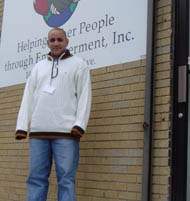BALTIMORE - At 7 a.m., Earl Carter-Bey, a 59-year-old man who walks
with the aid of a cane, leaves the site of the former Elmer Henderson
Elementary School in East Baltimore, which the city now uses as an
overnight shelter for homeless people. Other people walk out. A large
flock of gulls munch on bread crumbs scattered on the thick sheet of ice
that covers the yard. A string of boarded-up rowhouses stand to the
south as Carter-Bey moves slowly, step by step, attempting to catch a
van that would take him to HOPE, a daytime shelter in southeast
Baltimore.
Someone shouts that the van is full as he crosses North
Washington Street. “I still wanna catch it,” he says very softly. But
the van leaves without him.
Moments later, Carter-Bey catches a bus, showing up at HOPE a half hour
later.
HOPE, short for Helping Other People Through Empowerment, aids homeless people who have been diagnosed with mental illness. For
people like Carter-Bey, who have no other place to go, HOPE provides a
refuge from the streets.
The federally and state-funded shelter is consumer-run--the only one of
its kind in Maryland, said Sue Diehl, president of Baltimore Mental Health
Systems.
Its director and staff have been homeless, or suffered from mental
illness or drug addiction, or have had some dealings with someone who has
been in those situations.
Ninety-five percent of the employees have a major mental illness,
according to literature provided by HOPE.
“The clients are able to identify totally with the personnel,” said
Clarissa Netter, HOPE’s former executive director and first board president.
Carter-Bey has been homeless for three years. He said he was diagnosed
with schizoaffective disorder in 1994. His only income comes from Social
Security.
“I can’t work no more,” he says. “I am very sick and have high blood
pressure.”
He says he is unable to afford a place to live.
“It’s the landlords. You don’t have the right money, they put you out.
That is why there are so many homeless people in Baltimore City.
“It’s getting worse and harder. People are not looking out for people no
more. People are not trying to help each other. It’s all about money.”
Carter-Bey said that on a recent morning he got kicked out of another
shelter at 5:30 a.m. Until HOPE opened at 8:30 a.m., he just walked around.
 |
| Thomas
Hicks, director of HOPE, outside the shelter.
(Maryland Newsline photo by Diego Mantilla) |
Peer Counselors, Phones and Washing
Machines
The shelter opened in January 2000 after a survey was conducted at
various psychiatric rehabilitation programs to determine what kinds of
help was needed for homeless people diagnosed with mental illness,
Netter said.
“We learned the things you see in the center,” she said. Those included
the need to provide access to telephones, showers, washers, driers, some
type of snack and, most important, peer support counselors.
The shelter served 719 people last year, according to Executive Director
Thomas Hicks—up from 425 in 2001. (The numbers, though, are not exact, Hicks
said. If someone came, left, and then returned months later, he or she could
have been counted more than once.)
Before helping start HOPE, Netter said she had been close to being
homeless.
She used to work as a rental manager in an apartment complex. She lost
her job after suffering what she described as “a major mental breakdown.”
She said she and her children lived in an apartment without hot water and
electricity for months. She then moved in with relatives until she was able
to regain financial stability.
“It took me three years to get a job working one day a week,” she said.
Netter has been diagnosed with schizoaffective disorder.
J’Nay Jones, who also has been diagnosed with schizoaffective disorder,
has been working at HOPE as a peer support specialist for about three weeks.
On a recent Tuesday she called people on the list to use the washer:
“Dennis. Dennis. Dennis going one, twice, OK -- next.”
She said it is important for staff to understand what people with mental
illness are going through.
“That’s why I like the title peer,” she said.
One of the Best
On another day, Ken Vogelpohl, a 47-year-old man who became homeless in
March, sat facing away from the television in the social area of the
shelter.
“They do a lot of stuff here in this shelter,” Vogelpohl said. “This is
one of the best. The staff is really decent. They are very kind. They treat
you with respect and dignity.”
Vogelpohl, who said he is chronically ill and suffers from a heart condition,
has been homeless for about a year. He said he used to receive disability
income from Social Security. He lost it after failing to recertify his
condition.
He said he was unaware that he had to recertify his condition
periodically in order to continue receiving a Social Security check.
According to the Social Security Administration, nonpermanent impairment
disability cases come up for review every three years.
Unable to pay rent, Vogelpohl was evicted. Explaining his first day
without a home, he said it was like going “from peace of mind to a survival
mode.” He descibed how the cold weather makes the street, an already
inhospitable place, doubly hard on people who have fragile health.
“Because of my health and being hospitalized, the streets are physically
demanding. You move up and down stairs. It is physically demanding for
people who are ill,” Vogelphol said.
He said he had to keep moving in order to retain some body heat. “In the
winter time, if you don’t keep moving, the streets will kill homeless
people.”
Vogelpohl has been diagnosed with panic disorder.
